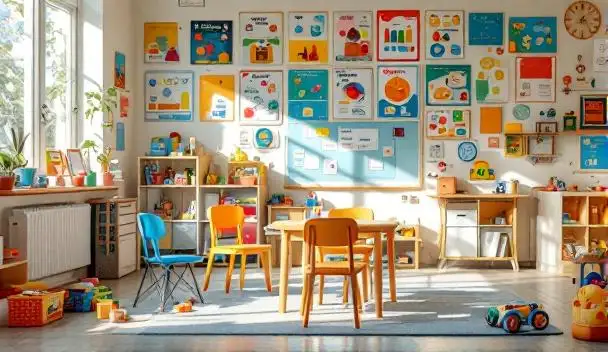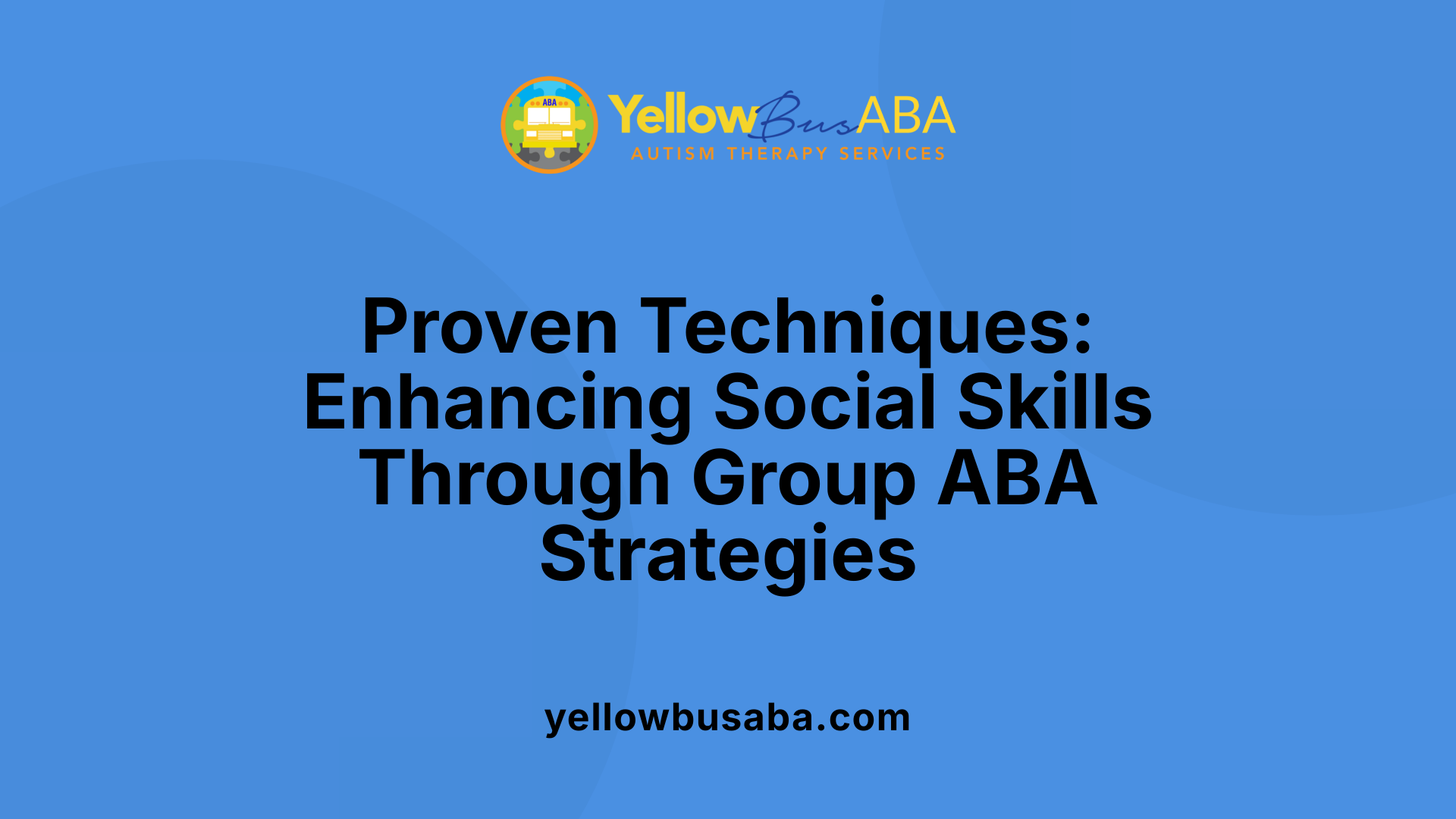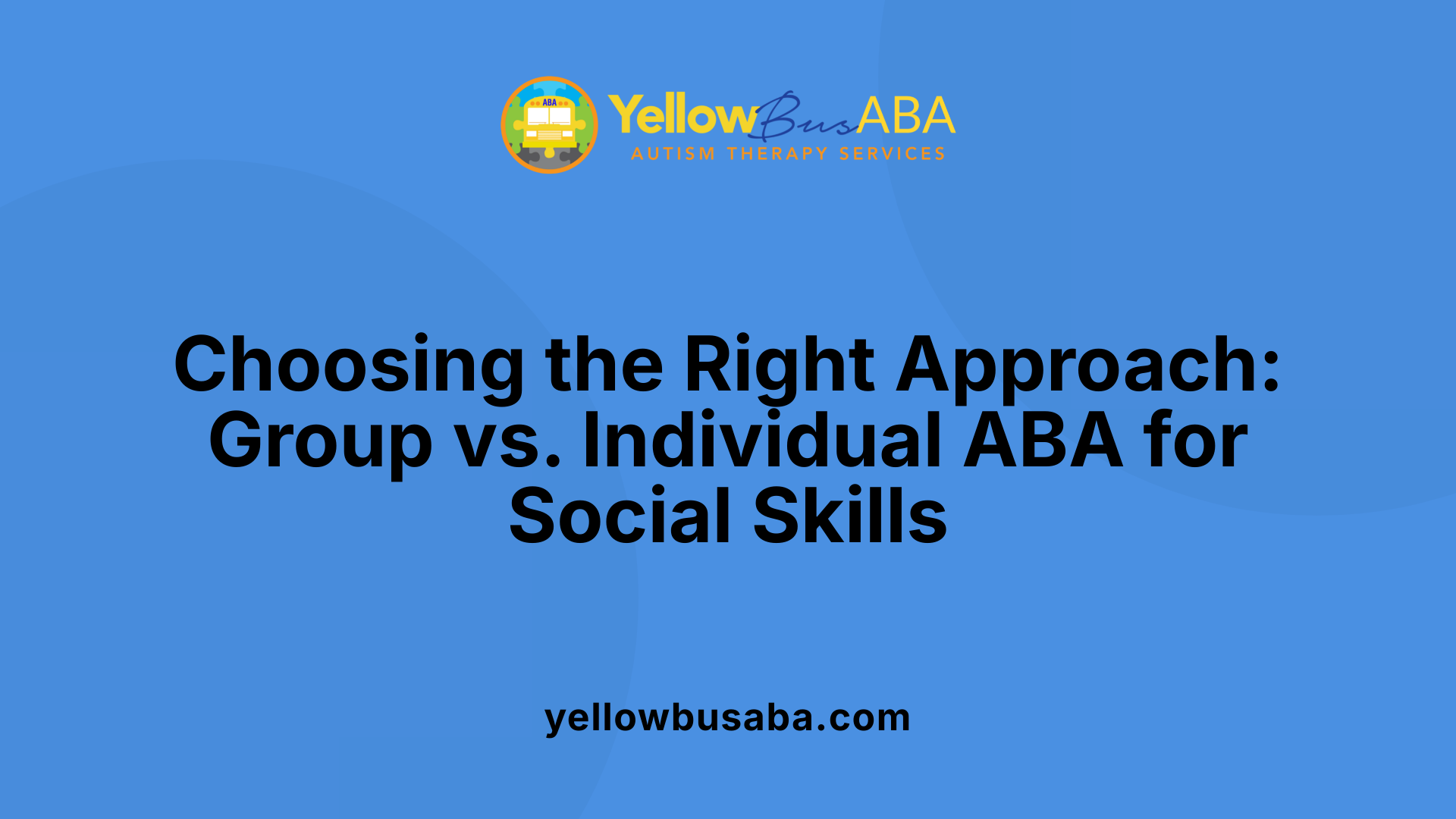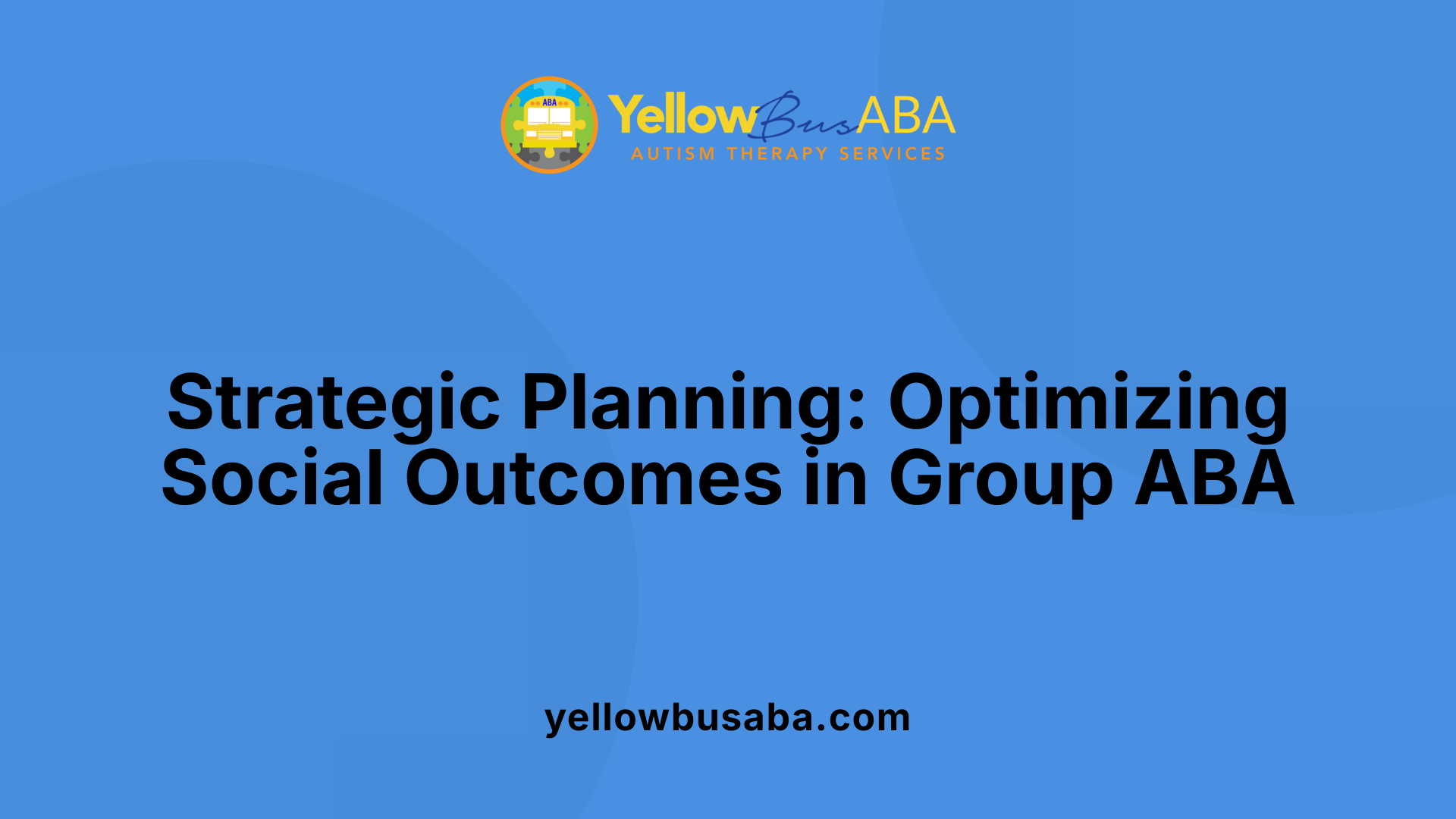The Benefits of Group ABA Therapy for Socialization and Peer Interaction
September 15, 2025
Unlocking Social Potential: How Group ABA Therapy Empowers Children with Autism

Understanding the Power of Group Settings in Social Skills Development
Group ABA therapy has emerged as a highly effective approach for fostering social skills and peer interaction among children with Autism Spectrum Disorder (ASD). Structured programs that incorporate peer engagement, role-playing, and collaborative activities create a safe and supportive environment where children can practice, learn, and generalize vital social behaviors. This article explores the myriad benefits of group ABA therapy, the techniques used, and how it compares to individual interventions in promoting meaningful social development.
The Core Benefits of Group ABA Therapy for Social Skill Development

What are the benefits of group ABA therapy for developing social skills?
Group Applied Behavior Analysis (ABA) therapy provides a structured and supportive environment that is ideal for helping children with autism develop vital social skills. Through carefully planned activities, kids have opportunities to observe their peers and imitate appropriate social behaviors, which fosters natural learning.
One of the primary advantages of group ABA therapy is its emphasis on peer interaction. Children participate in activities like collaborative games, role-playing, and shared projects such as mural creation. These activities promote sharing, turn-taking, and effective communication, allowing children to practice these skills in real-time.
The group setting also enhances social understanding. Children learn to read social cues, respond to greetings, and maintain eye contact. These visible and interactive cues help build confidence and decrease social anxiety. Consistent exposure to social norms in a group encourages children to generalize these skills beyond therapy, making them more applicable in everyday situations.
Another significant benefit is observational learning. Kids watch and imitate their peers, which helps reinforce positive behaviors. Peer modeling and the use of reinforcement strategies, like praise or tangible rewards, motivate children to engage and try new social interactions.
Furthermore, social skills groups foster a sense of belonging. Children who participate regularly report feeling more connected with others, which can lead to friendships and improved social inclusion. These benefits extend beyond the therapy sessions, helping children feel more comfortable engaging with peers at school, extracurricular activities, and community events.
Overall, group ABA therapy enhances communication, social interaction, and emotional regulation. It supports children in building self-confidence, forming friendships, and participating actively in their communities.
| Benefit | Description | Example Activity |
|---|---|---|
| Social Skills Acquisition | Learning new social behaviors through structured routines and peer interaction. | Turn-taking games, role play. |
| Peer Interaction Enhancement | Improving the ability to interact naturally with peers. | Collaborative art projects. |
| Confidence Building | Gaining self-assurance in social settings. | Sharing achievements with peers. |
| Social Inclusion | Feeling part of a community and developing friendships. | Group discussions, social outings. |
Fostering Peer Interaction Through Structured Engagement
How does group ABA therapy impact peer interaction among children with autism?
Group ABA (Applied Behavior Analysis) therapy has a significant influence on improving peer interactions for children with autism. It creates a controlled, supportive environment where children can learn essential social skills alongside their peers.
Within this setting, strategies such as modeling, prompting, and reinforcement are used to teach children how to initiate conversations, respond appropriately, share, and develop friendships. These techniques help children practice social behaviors in real-time, making the learning process engaging and effective.
One effective method involves involving peers directly in activities, which encourages natural social exchanges. For example, children might work together on academic tasks or play collaboratively during center time, giving them hands-on experience in social situations that mirror real-world contexts.
Peer-mediated interventions are also prominent in group ABA. These involve typically developing peers who support children with autism by modeling social behaviors and facilitating interactions. Not only does this foster collaboration and empathy, but it also enhances communication skills.
Participation in social skills groups and group therapy sessions further helps children learn how to interpret social cues, manage emotions, and respond to others. As children practice these skills regularly, they tend to show increased social initiations, responses, and overall engagement.
Consequently, these experiences promote positive peer relationships and contribute to broader social development. Children become more confident in social settings and are more likely to carry these skills outside therapy, such as in school or community activities.
In summary, structured group ABA therapy actively fosters peer interaction by providing opportunities to learn and practice social skills in a safe, nurturing environment. It not only improves immediate social behaviors but also supports long-term social integration and friendship building in children with autism.
Techniques and Strategies to Improve Socialization Skills

What techniques are used in group ABA therapy to improve socialization?
Group ABA therapy incorporates a variety of proven methods to help children with autism develop essential social skills. These techniques create engaging, supportive environments where children can learn, practice, and reinforce positive social behaviors.
One common approach involves social stories. These are carefully crafted narratives that describe social situations, explain expected behaviors, and provide perspective. Social stories help children understand social norms and anticipate others' reactions, making social interactions less confusing and more predictable.
Role-playing is another effective strategy. In controlled settings, children practice real-life social scenarios like greeting peers, sharing, or taking turns. This hands-on experience builds confidence and helps children learn appropriate responses.
Video modeling uses videos showing desired behaviors for children to observe. By watching peers or adults demonstrate social skills like initiating conversations or responding to social cues, children can imitate these actions. Video modeling caters especially well to visual learners and shows examples in an engaging format.
Reinforcement is fundamental across these techniques. When children display desired social behaviors, they receive tangible, social, or activity-based rewards. This positive reinforcement increases the likelihood these behaviors will recur, gradually shaping better social habits.
Natural Environment Training (NET) emphasizes practicing skills in everyday settings such as playgrounds, family outings, or school environments. This integration ensures that social skills are not only learned but also generalized to real-world situations, leading to meaningful social engagement.
Other strategies like modeling desired behaviors, structured peer interactions, and success-based prompting further support social development. These methods, rooted in the principles of applied behavior analysis, ensure that children build skills that last and transfer beyond therapy sessions.
Overall, a combination of social stories, role-playing, video modeling, reinforcement, and natural environment training makes group ABA therapy a powerful approach for enhancing social skills in children with autism. These techniques work together to foster confidence, promote understanding, and encourage active participation in everyday social exchanges.
Supporting Social Development in Naturalistic Settings
How does group ABA therapy assist children with autism in developing social skills?
Group ABA therapy plays a vital role in nurturing social abilities among children with autism by offering a well-structured environment where peer interactions are encouraged. Children participate in activities like role-playing, social stories, and collaborative games that teach them to recognize social cues, take turns, and communicate effectively. These sessions are designed to break down complex social behaviors into smaller, manageable steps, making it easier for children to learn and practice.
A significant aspect of group ABA is the use of reinforcement strategies. When children display desired behaviors—such as initiating a conversation or sharing—these behaviors are rewarded, promoting repetition and mastery. This approach helps children build confidence and independence in social settings.
Involving parents, teachers, and caregivers is crucial in generalizing the skills learned during therapy. Consistent reinforcement across different environments ensures that children apply their new skills in real-world situations, fostering more natural and meaningful interactions.
Through targeted activities and ongoing support, group ABA therapy helps improve communication, emotional regulation, and social understanding. As children develop stronger social skills, they are more likely to form friendships, experience emotional well-being, and participate actively in their communities.
What is natural environment training (NET) and how does it support social skills?
Natural Environment Training (NET) involves teaching social skills in everyday settings like playdates, family outings, or school environments. This approach emphasizes learning in real-life contexts, which helps children generalize their social abilities beyond therapy sessions.
How do community outings contribute to social development?
Community outings provide invaluable opportunities for children to practice social skills in diverse situations. These experiences expose children to different social cues, routines, and interactions, enhancing their adaptive abilities and confidence in real-world settings.
What is the role of family involvement in supporting ongoing social development?
Families and caregivers are essential partners in reinforcing social skills outside structured therapy. Their active participation, through consistent practice and positive reinforcement, helps sustain progress and supports the child's overall social growth.
| Aspect | Description | Benefits |
|---|---|---|
| Group ABA Sessions | Structured group activities led by therapists | Learning social cues, cooperation, communication |
| Natural Environment | Skills practiced in daily life settings | Skill generalization, real-world application |
| Community Outings | Social participation in parks, stores, events | Confidence, social understanding, peer interaction |
| Family Involvement | Parental reinforcement and practice at home and in community | Consistency, reinforcement, ongoing support |
Supporting children's social development requires a comprehensive approach that combines structured group therapy, real-life practice, and family reinforcement. Together, these strategies foster meaningful social interactions, build confidence, and promote inclusion within their communities.
Comparison Between Group and Individual ABA Approaches

How does group ABA therapy compare to individual therapy in promoting social skills?
Group ABA therapy plays a vital role in helping children develop social skills by offering settings rich in peer interactions. These structured environments allow children to practice communication, cooperation, and understanding social norms through activities like role-playing, group games, and collaborative tasks such as creating murals. Such activities encourage sharing, turn-taking, and verbal exchanges, which are essential for social development.
In contrast, individual ABA therapy provides personalized, one-on-one attention. Therapists can tailor interventions to target specific deficits, offering direct support and rapid skill acquisition. For example, a child struggling with eye contact or understanding social cues can work closely with a therapist to improve those areas without distractions.
Combining both methods often yields the best outcomes. Individual therapy helps establish a strong foundation of social skills, which can then be practiced and generalized in group settings. This holistic approach ensures that children not only learn necessary skills but also apply them in real-life social situations, fostering greater confidence and peer relationships.
Ultimately, the decision depends on the child's unique needs and preferences, but an integrated approach often offers comprehensive support for social skill development.
Structure and Implementation of Group ABA Sessions

What is the typical structure and implementation of a group ABA therapy session focused on social skills?
Group ABA therapy sessions designed to develop social skills follow a well-organized framework that combines engaging activities with evidence-based interventions. The process begins with an assessment and clear goal setting to identify each child's specific social skill needs, such as sharing, eye contact, or understanding social cues.
A core component of the session involves structured activities that promote peer interaction and cooperative behaviors. These may include group games that require turn-taking, collaborative tasks like creating murals or craft projects, and role-playing scenarios that simulate real-life social situations.
Sessions are usually conducted with small groups of three to six children. This group size strikes a balance between providing sufficient peer interaction opportunities and ensuring individual attention from the therapist.
Therapists play a vital role, guiding activities, modeling appropriate behaviors, and providing prompts when necessary. They utilize reinforcement strategies such as verbal praise, tokens, or activity rewards to motivate children and reinforce desired social behaviors.
Throughout the session, therapists continuously collect data on each child's progress, observing behaviors like initiating conversations, responding to social cues, and sharing with peers. This ongoing monitoring informs adjustments to intervention plans, ensuring that each child's development remains on track.
The combination of structured activities, professional guidance, and data-driven approaches makes group ABA sessions an effective way to teach, practice, and generalize social skills, ultimately fostering greater confidence and social integration for children with autism.
Positive Outcomes and Long-Term Benefits
What outcomes have been observed in peer relationships from participating in group ABA therapy?
Children with autism who participate in group ABA therapy often experience significant improvements in their peer relationships. During these structured group sessions, children learn essential social skills such as sharing, taking turns, initiating conversations, and understanding social cues.
These activities foster more natural interactions and help children develop stronger connections with their peers. As they practice social exchanges in a safe, supportive environment, their communication skills tend to improve, leading to better engagement in social situations.
Studies reveal that such participation results in enhanced emotional-social competence and adaptive behaviors, which are crucial for daily functioning and social integration. Peer modeling and collaborative activities like creating murals or playing group games further accelerate social learning.
The consistent involvement in group therapy promotes comfort and confidence in social settings, encouraging children to engage more outside of therapy, whether in school or community activities. This progression supports the development of meaningful friendships and increased social inclusion.
Research indicates that children who engage in group ABA sessions display notable improvements in social skills and peer interactions, making these programs valuable for fostering long-term social competence.
| Aspect | Outcome | Details |
|---|---|---|
| Peer relationship improvements | Stronger peer bonds | Increased sharing, cooperation, and social understanding |
| Social skill development | Better communication | Improved eye contact, turn-taking, verbal and non-verbal cues |
| Emotional well-being | Higher confidence | Reduced anxiety, increased self-esteem |
| Quality of life | Greater inclusion | Better participation in social activities and friendships |
Engaging children in these group environments not only enhances their immediate social skills but also contributes to their overall emotional health and social independence, leading to more positive long-term outcomes.
Supporting Communication and Social Engagement in Daily Life
How does group ABA therapy contribute to improving communication and social engagement in children with autism?
Group ABA therapy plays a vital role in enhancing social and communication skills among children with autism. By integrating structured activities such as role-playing, modeling, and peer-mediated interventions, children learn essential social behaviors like initiating conversations, sharing, and interpreting social cues.
These sessions create a safe, supportive environment with clear routines that help reduce anxiety and encourage active participation. Personalizing goals based on each child's interests and needs keeps them motivated and engaged. The use of positive reinforcement and visual aids bolsters both verbal and non-verbal communication, making social interactions more accessible and effective.
Within social skills groups, children practice and imitate behaviors in real-time social contexts. This offers opportunities for modeling social skills, practicing them with peers, and ultimately generalizing these skills outside therapy to everyday situations like playdates, school, and community activities.
Continuous assessment by trained professionals ensures that therapy goals remain aligned with the child’s evolving needs. Collaboration with families and educators helps reinforce these skills across various environments, promoting ongoing social development.
Overall, group ABA therapy helps children with autism build confidence in their social abilities, establish meaningful peer relationships, and participate actively in their communities. This approach supports not just skill acquisition but also the transfer of these skills into everyday life, fostering independence and social inclusion.
| Therapy Component | Purpose | Examples |
|---|---|---|
| Structured activities | Teach and reinforce social behaviors | Role-playing, social stories, collaborative games |
| Reinforcement | Encourage desired behaviors | Tangible rewards, praise |
| Peer involvement | Foster natural social interactions | Peer-mediated interventions |
| Visual supports | Aid understanding and communication | Picture exchange, visual schedules |
| Ongoing assessments | Tailor and adapt goals | Observation, progress tracking |
In conclusion, group ABA therapy offers a comprehensive framework for developing social and communication skills that children can apply across different settings, ultimately improving their quality of life and social integration.
The Evidence Base Supporting Group ABA Therapy
Research highlights the strong support for using group ABA therapy to improve social skills in children with autism Spectrum Disorder (ASD). Multiple peer-reviewed studies consistently show that this approach leads to significant gains in social interaction, communication, and adaptive behaviors.
Specific research findings indicate that children participating in group ABA sessions—featuring activities such as role-playing, cooperative games, and social stories—experience noticeable and lasting improvements in social behaviors. These improvements are often sustained over follow-up periods from 16 to 32 weeks after the intervention has ended.
The effectiveness of group ABA is reinforced by rigorous data analysis, including multivariate analyses and MANCOVA tests, with statistically significant results (p < .05). Caregiver reports and observations by trained professionals confirm these outcomes, lending further credibility.
Over 1,000 studies support the efficacy of group ABA, highlighting its role in reducing social challenges like separation anxiety and helping children better understand social cues and norms. Endorsements from prominent health organizations advocate for its use, emphasizing that this structured intervention provides a safe and effective environment where children can learn and practice crucial social skills.
In summary, the consistent and substantial evidence from diverse research sources underscores that group ABA therapy is a valid and powerful method for enhancing social skills among children with autism, promoting their social inclusion and overall well-being.
Maximizing Socialization Outcomes Through Strategic Planning

What strategies can be used to maximize socialization benefits in group ABA therapy sessions?
To ensure children gain the most from group ABA therapy, careful activity planning is essential. One effective approach involves structuring activities that naturally promote social interaction, such as games that require turn-taking or sharing, like relay races or board games. These activities encourage cooperation and develop social skills in a fun, engaging way.
Modeling and role-playing are also vital techniques. By demonstrating appropriate behaviors and practicing scenarios through social stories, children learn how to respond and interact in real-life social settings. Reinforcers such as praise, tokens, or privileges motivate children to practice and reinforce positive social behaviors.
Peer modeling forms another cornerstone of successful group strategies. When children observe their peers exhibiting social skills, they are more likely to imitate and adopt these behaviors. Facilitated peer interactions create a natural environment for practicing social cues, emotional regulation, and communication.
Technology can be incorporated to enhance learning outcomes. Video modeling allows children to observe ideal behaviors and replicate them, which is especially helpful for visual learners. Virtual scenarios or computer-based activities provide diverse opportunities to practice social skills in different contexts.
Parent involvement remains crucial outside therapy sessions. Training caregivers to reinforce skills at home and during community activities fosters consistency and helps children generalize what they learn in therapy.
Overall, combining activity structuring, peer modeling, technological tools, and family involvement creates a comprehensive approach to maximizing social development in children participating in group ABA sessions.
Fostering Lifelong Social Skills and Inclusion
Overall, group ABA therapy is a powerful approach for supporting the social development of children with autism. By providing structured, engaging, and evidence-based interventions, it helps children acquire critical social skills, improve peer interactions, and build meaningful relationships. The collaborative nature of group settings, when combined with individualized goals and active caregiver involvement, ensures that children can transfer their skills to everyday environments, ultimately fostering lifelong social inclusion and community participation. As research continues to validate its effectiveness, group ABA remains an essential tool for creating inclusive, supportive communities where children with autism can thrive.
References
- Building Peer Connections: Autism Group Activities
- How ABA Therapy Helps Improve Social Skills in Children
- ABA Therapy's Impact on Peer Interaction and Communication
- A Comprehensive Guide to What Social Skills Groups Are
- Group Instruction in ABA: A Practical Guide - Alpaca Health
- Guide to Running Effective ABA Group Therapy Sessions
- The Ultimate Guide to Creating Fun ABA Therapy Sessions
- Group Instruction in ABA: A Practical Guide - Alpaca Health




.avif)

